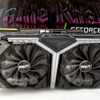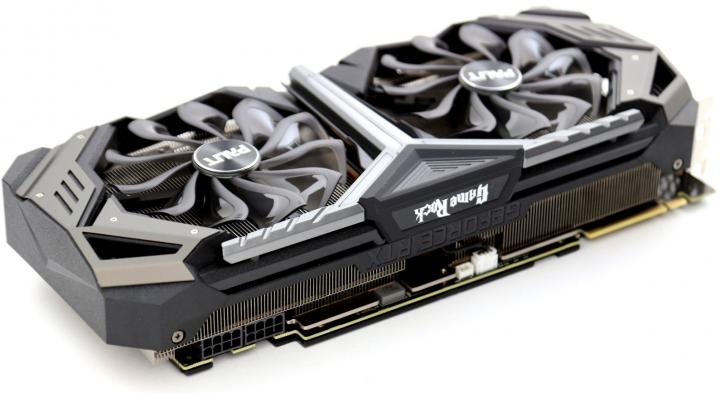Conclusion
Conclusion
It is good to see Palit in the RTX reviews, this brand always puts out graphics cards that offer a bit more value for money whilst offering a quality product. It's not different with the GameRock really. Where others pass that 1000 EURO marker for the RTX 2080, this GameRock version you'll spot at giving or take € 849,- And for that money, you receive a product that is properly cooled and virtually inaudible. From our point of view, PALIT has done a good job with the RTX 2080. And while you can discuss the 2080 performance positioning overall, it's validity and overall price level, we need to focus on what the board partners do with it. The Gamerock Premium edition sees a shy factory tweak that will offer you a bit more perf, that tweak remains trivial though. The card does have a proper cooler applied to this GPU and that shows with load temps of just 65 Degrees C.
Aesthetics
Looking at the GameRock, honestly, it's not a bad looking card at all eh? The overall dark design works quite well for what is considered to be a more value proposition within the RTX 2080 range. The LED RGB design can be turned off, or set to a color of preference. Nice to see is that the back-plate has a big opening at the GPU location, we like that. I'd like to see more vents at the VRM area though. But as vents go, this one is pretty okay. The backplate itself is really busy on the eyes though with the Gamerock logo and all the stickers. I would advise Palit to be a bit more subtle here. What I also would have liked to see would have been a black IO plate for that bit of an extra premium feel. Overall though, look below, personally, I like that look .
Cooling & Noise Levels
Palit has got a nice cooler this round. With the BIOS set at its default Perf mode, you sit in a 36 DBa range which means you can hardly hear the product, this is considered silent. Realistically though, it's 1 DBa away from the founders card though, that has to be said. It achieves that acoustics value under full load with a GPU temp at 65 Degrees C, and that's a lovely value and roughly 6 degrees C better than the founders card. So yeah, while card might be a bit thicker due to adding radiator surface area, it, however, does cool the GU104 really well plus you get options, we like that. I mentioned it already but we have been able to hear a tiny bit of coil whine every now and then. We do test on an open platform, and inside a chassis, you'll be hardpressed to hear it, but it's there at higher frequencies/FPS.
Power Consumption
Graphics cards with a TU104 sit at a 225 Watt TDP under full stress, our measurements show it to be roughly 20 Watts higher due to the factory tweak from Palit. A 600 Watt PSU would be a nice match for these cards paired with a modern age PC. Remember - when purchasing a PSU, aim to double up in Wattage as your PSU is most efficient when it is at 50% load. Here, again, keep in mind we measure peak power consumption, the average power consumption is a good notch lower depending on GPU utilization. Also, if you plan to overclock the CPU/memory and/or GPU with added voltage, please do purchase a power supply with enough reserve. People often underestimate it, but if you tweak all three aforementioned variables, you can easily add 150 Watts to your peak power consumption budget as increasing voltages and clocks increase your power consumption.
Overclocking
The combination of memory, power and voltage settings will bring you a proper overclock. Once you've applied it, you get more performance. The real gurus, of course, will likely prefer a manual tweak. Here we cannot complain either. We gained 85 MHz extra on top of the factory tweaked values. With the increased power limiter you'll now see that dynamic boost frequency hovering at and over the 2050 MHz range. Mind you, that frequency can be higher and/or lower depending on game and benchmark title. The memory clock tweak was far more complicated, we've been able to add 1000 MHz, double that for a double-data-rate and, yes, we had close to 16 Gbps running stable. Which is still nice when you think about it for a few seconds. We like the new OC Scanner that you will see throughout most GPU tweak utilities, for us that is Afterburner (download). While it only overclocks your GPU a notch, it does create a reliable tweaking curve. It probably needs a bit more development and finetuning, but I can see this become the primary methodology for automated overclocking in the future. Right now it is a little conservative though, but yes, promising. Just remember to increase the power limiter and your stable memory tweak.
Concluding
I'll keep repeating that NVIDIA might have shot itself in the foot with the pricing levels of the RTX 2080 and 2080 Ti. The good news is that Palit always offers competitive prices compared to other AIB products. We are seeing several of their SKUs at a proposed €849,- which arguably is still a massive amount of money with the RTX 2080 series. The biggest problem is that the founder edition cards have become much more competitive with their competing clocks and cooling design. Since the founders cards sell at €799,- the extra 50 bucks remains hard to justify. This is a problem that NVIDIA created, as they are now competing with their board partners. Palit overcomes that difference with the help of an improved VRM design as it has 10+2 phases compared towards the 8+2 configuration for the Founders Edition. Next, to that you receive a more premium cooling solution. But sure, pricing is off for the RTX 2080 series. But relatively speaking among the AIB cards, Palit manages this well (being competitive pricing wise). Typically for the value products, some compromises need to be made, and I don't have that feeling with the card as tested today. The PCB layout and component usage are good, the cooler I would qualify as excellent even. Palit really did design a card that works really well, proper cooling at a very low acoustic level. We did notice that in idle the fans will remain active. However, it is at such a low RPM that you simply can not hear them. We also like the dual-bios, you will probably never need it, but if you do, it's handy to have a fail-safe BIOS. Overall this was a good and proper RTX 2080 to have tested. The factory tweak is nice, but we're talking about 2% extra performance at best. That is the nature of the beast these days with all the limiters that NVIDIA invokes. Tweaking wise the card did not disappoint though. At this time we're giving 'recommended awards' solely to the RTX series mainly due to the lack of RT game testing, as well as its very high overall price level. That said, Palit did a nice job here, but is would be even nicer to see this product more on par with the founders edition, pricing wise.
Recommended Downloads
- Sign up to receive a notice when we publish a new article
- Or go back to Guru3D's front page



